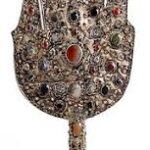
Jewish Hand symbol
| Symbol | Jewish Hand |
| Religion | Judaism |
| Origin | Rooted in ancient Middle Eastern traditions, symbolizing protection against the "evil eye." |
| Meaning | Represents blessings, strength, and good fortune, with cultural variations in interpretations. |
| Appearance | Typically an open right hand with an eye in the center, featuring variations in design and details. |
| Colors | Various colors, with blue often used for its protective qualities. |
| Usage | Commonly used in jewelry, art, and decor for its spiritual and protective significance. |
| History | Has a rich historical background, transcending religious boundaries and evolving over centuries. |
| Popularity | Globally popular, symbolizing unity and embraced beyond its cultural origins. |
| Importance | Holds cultural and spiritual importance, regarded as a symbol of divine protection. |
| Complexity | Diverse interpretations contribute to its complexity, with meanings evolving across regions and religions. |
| Emotions | Evokes a sense of spiritual connection and protection, conveying positive emotions and cultural significance. |
- Sure, here is a summary text for the Jewish Hand symbol, also known as the Hamsa:
The Hamsa is a palm-shaped amulet popular in many cultures, including Judaism, Islam, and Christianity. It is typically depicted as an open right hand with five fingers and often features an eye in the center of the palm. The word “Hamsa” comes from the Arabic word for “five,” which represents the five fingers on the hand.
The Hamsa is a symbol of protection against evil, misfortune, and the “evil eye.” It is also believed to bring good luck,happiness, and health. The eye in the center of the palm is a particularly powerful symbol of protection, and it is often said to ward off the jealous gaze of others.
The Hamsa has been used by Jewish people for centuries, and it is a common symbol in Jewish art and jewelry. It is also found in many Jewish homes and synagogues. In recent years, the Hamsa has become more popular among non-Jews as well, and it is now seen as a symbol of peace and understanding between different cultures.
Here are some additional details about the Hamsa:
- The Hamsa is also known as the Hand of Miriam, after the sister of Moses, or the Hand of Fatima, after the daughter of the Prophet Muhammad.
- The Hamsa can be made from a variety of materials, including metal, glass, and wood.
- The Hamsa can be worn as a pendant, necklace, or bracelet.
- The Hamsa can also be displayed in the home or office.